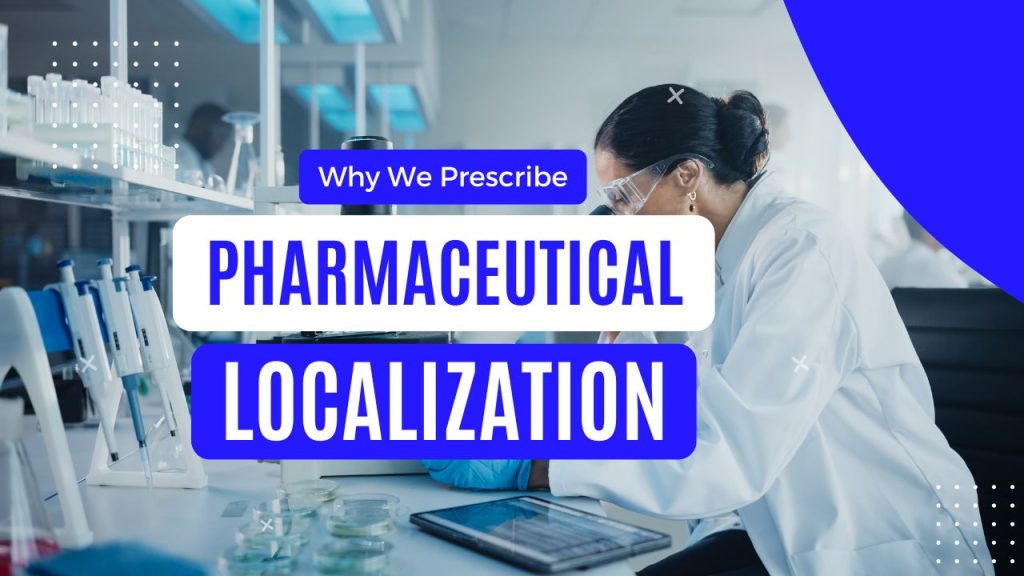
Discover the compelling reasons why pharmaceutical localization is essential for improving regulatory compliance, patient safety, and market penetration.
Pharmaceutical localization refers to the adaptation of pharmaceutical product information and related materials to meet the regulatory, cultural, and linguistic requirements of a specific country or region.
It’s a process that plays a pivotal role in global expansion of pharmaceutical companies. It helps tailor medicinal products to align with specific requirements of varied geographical regions.
This article serves as a beginner’s guide to understanding the fundamentals of pharmaceutical localization.
What is pharmaceutical localization?
Pharmaceutical is an intricate procedure that demands an in-depth knowledge of medical and legal terminology in the respective language, along with a profound familiarity with the pharmaceutical regulations and cultural norms of the specific area.
The process ensures that important medical treatments are not limited by language or cultural barriers.
With the high stakes of healthcare outcomes on the line, it’s an area where accuracy is paramount. It requires precision, care, and a specialized understanding that goes beyond standard translation efforts.
You can’t rely on fully automated measures, either. Human touchpoints are so important here.
Simply put, pharmaceutical localization is the bridge that allows a drug or device to travel from its place of creation to anywhere in the world. It ensures that the science can be applied universally, providing safe, effective treatment for patients across the globe.
Key Elements of Pharmaceutical Localization
At its core, pharmaceutical localization is about ensuring that crucial details about medicines and health products are available and comprehensible to local patients and healthcare providers.
The right information must be accessible in the right language and with cultural considerations being taken into account.
Here are three key elements to keep in mind.
Packaging and Labelling
Adapting packaging and labelling to meet local regulatory requirements and consumer preferences is essential for pharmaceutical localization.
Clear and accurate labelling ensures that patients can safely use the product and understand important information such as dosage instructions, side effects, and expiration dates.
Patients can better understand important information about their medication, leading to improved health outcomes.
Marketing, Branding, and Training
Tailoring marketing strategies and branding initiatives to local cultures and preferences helps pharmaceutical companies build brand recognition and loyalty in new markets.
Localized marketing campaigns resonate with consumers and differentiate pharmaceutical products from competitors.
Localizing educational materials, training programs, and interactions with healthcare professionals also help pharmaceutical companies establish strong relationships with local healthcare providers.
Improved understanding and communication between pharmaceutical companies and healthcare professionals lead to more effective prescribing practices and product recommendations.
Supply Chain Management
Optimizing supply chain processes to meet local distribution, storage, and transportation requirements is critical for pharmaceutical localization.
Adapting pharmaceutical products to meet local regulatory requirements is a crucial starting point for obtaining market approval. Pharma localization ensures that products align with specific regulatory standards, speeding up the approval process and facilitating market access in different regions.
Efficient supply chain management ensures that products are delivered on time and in compliance with regulatory standards, minimizing logistical challenges and disruptions.
The key benefit is patients and medical professionals correctly understanding the instructions, dosages, and possible side effects of a drug.
The result is that risks related to misunderstanding or misuse are significantly reduced.
Strategies for Successful Pharmaceutical Localization
Navigating the intricate process of pharmaceutical localization can appear overwhelming, but it’s entirely feasible with careful planning and the right tactics.
Here are some valuable strategies that can help ensure success:
Engage professional langue service providers.
The specialized nature of pharmaceutical localization necessitates a deep knowledge of medical terminologies, local culture, and language. Collaborating with expert medical translators can provide the much-needed precision and expertise for this task.
Leverage localization tools.
Cutting-edge localization technologies can help automate and streamline the process, enhance consistency, and minimize potential errors. These tools can greatly improve the efficiency and accuracy of the localization process.
Thoroughly grasp local regulations.
Every region has its unique set of laws and regulations governing pharmaceuticals. It’s imperative to have a solid understanding of these standards to ensure total compliance and avoid legal complications.
Implement robust quality control measures.
The gravity of errors in pharmaceutical localization requires stringent quality assurance checks and validation mechanisms. These measures help ensure the final localized content is accurate, effective, and compliant with the target region’s standards.
Executing successful pharmaceutical localization involves a balance of expert human skills and advanced technology. It’s about thorough knowledge of local regulations, meticulous translation, and stringent quality assurance.
By implementing these strategies, project managers can guide their teams in accomplishing these pivotal projects, making a meaningful impact on global health access.
Navigating medical and pharmaceutical localization is a multi-faceted journey requiring deep knowledge, precision, and a commitment to quality. Are you ready to undertake this critical process and make a global impact? Take the first step today!


